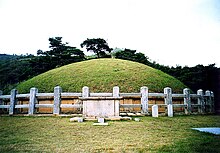
Back گیۆنگدۆکی شیللا CKB پادشاه گیونگ دئوک Persian Gyeongdeok dari Silla ID 景徳王 Japanese 경덕왕 Korean Gyeongdeok od Sille Serbo-Croatian พระเจ้าคยองด๊อกแห่งชิลลา Thai Кьондок Ukrainian Cảnh Đức vương Vietnamese 景德王 Chinese
| King Gyeondeok 경덕왕 景德王 | |
|---|---|
| King of Silla | |
| Reign | 742–765 |
| Coronation | 742 |
| Predecessor | Hyoseong of Silla |
| Successor | Hyegong of Silla |
| Born | 723 |
| Died | 765 Silla |
| Father | Seongdeok of Silla |
| Mother | Queen Sodeok |
| Gyeongdeok of Silla | |
 King Gyeongdeok's tomb | |
| Korean name | |
|---|---|
| Hangul | 경덕왕 |
| Hanja | 景德王 |
| Revised Romanization | Gyeongdeok Wang |
| McCune–Reischauer | Kyŏngdŏk Wang |
| Birth name | |
| Hangul | 김헌영 |
| Hanja | 金憲英 |
| Revised Romanization | Gim Heon-yeong |
| McCune–Reischauer | Kim Hŏnyŏng |
| Monarchs of Korea |
| Silla |
|---|
| (Post-unification) |
|
Gyeongdeok of Silla (景德王; 742–765) was the 35th ruler of Silla and son of King Seongdeok (reigned 702–737). He succeeded his elder brother, King Hyoseong, the 34th ruler of Silla. His reign is considered a golden age in Unified Silla's history, particularly for Buddhist art and architecture.[1][2][3] He is noted as an intent patron of Buddhism and an influential political and religious individual.[4] King Gyeongdeok also made attempts to centralize the country through reorganizing government and standardizing naming practices.[1][5][6][7][8] With his mother as regent, Gyeongdeok's son, King Hyegong, succeeded him after his death.[9]
- ^ a b Tennant, Charles Roger, 1919-2003. (1996). A history of Korea. London: Kegan Paul International. ISBN 0-7103-0532-X. OCLC 33334921.
{{cite book}}: CS1 maint: multiple names: authors list (link) CS1 maint: numeric names: authors list (link) - ^ Pratt, Keith L. (2006). Everlasting flower : a history of Korea. London: Reaktion. ISBN 978-1-86189-273-7. OCLC 63137295.
- ^ Kim, Jeong-hwa (2003). "Manufacturing Technique of Gulbulsaji Four Surface Buddha Statue - Mainly for Seomyeon Amita Three Buddha Statues -". Komunhwa. 62: 59–85 – via KoreaScience.
- ^ Lee, Geun-jik (2009). "The Development of Royal Tombs in Silla" (PDF). International Journal of Korean History. 14: 122.
- ^ Cha, Soon-cheol (2009). "The Characteristics of Silla's Gongbang" (PDF). International Journal of Korean History. 14: 125–160.
- ^ Pellard, Thomas (2014). "The Awakened Lord: The Name of the Buddha in East Asia". Journal of the American Oriental Society. 134 (4): 689–698. doi:10.7817/jameroriesoci.134.4.689. JSTOR 10.7817/jameroriesoci.134.4.689 – via JSTOR.
- ^ Kim, Chong Sun (2004). "Silla Economy and Society". Korean Studies. 28: 75–104. doi:10.1353/ks.2005.0020. JSTOR 23720183. S2CID 145158628 – via JSTOR.
- ^ Ro, Jin Young (1983). "Demographic and Social Mobility Trends in Early Seventeenth-century Korea: An Analysis of Sanum County Census Registers". Korean Studies. 7: 77–113. doi:10.1353/ks.1983.0004. JSTOR 23717753. S2CID 162202551 – via JSTOR.
- ^ 김, 동완 (July 30, 2021). "[삼국유사 오디세이] 34. 황복사탑이 혜공왕을 점지한 천궁이었을까". 경북일보. Retrieved 28 February 2024.
© MMXXIII Rich X Search. We shall prevail. All rights reserved. Rich X Search